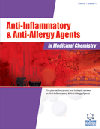- Home
- A-Z Publications
- Anti-Inflammatory & Anti-Allergy Agents in Medicinal Chemistry (Formerly Current Medicinal Chemistry - Anti-Inflammatory and Anti-Allergy Agents)
- Previous Issues
- Volume 6, Issue 4, 2007
Anti-Inflammatory & Anti-Allergy Agents in Medicinal Chemistry (Formerly Current Medicinal Chemistry - Anti-Inflammatory and Anti-Allergy Agents) - Volume 6, Issue 4, 2007
Volume 6, Issue 4, 2007
-
-
Editorial [Hot Topic: Chemical Approaches to Anti-Inflammatory Discovery (Guest Editor: Balbina J. Plotkin)]
More LessThe one bullet-one target approach to drug design where compounds exhibit a single specificity in action and function is generally the preferred design. However, there are multiple classes of agents with antiinflammatory activity that are multifunction with activity across taxonomic kingdoms, cell types and molecular targets. The aim of this volume is to examine the structure-function relationship for antiinflammatory agents w Read More
-
-
-
Antibiotic or Anti-inflammatory Agent? The Double-Edged Sword of Tetracyclines
More LessAuthors: K. K. Eklund and C. SandlerThe tetracyclines are broad-spectrum bacteriostatic antibiotics which interfere with the protein synthesis of bacteria at the ribosomal level. More recently the nonantibiotic properties of tetracyclines have attracted increasing interest. Since the initial observations that tetracyclines inhibit collagenases, extensive number of studies have shown that tetracyclines have effects on inflammation, proteolysis, angiogenesis, apopt Read More
-
-
-
Ethanol and Inflammation
More LessBy Joanna GoralEthanol (alcohol) consumption can modify immune responses. Moderate ethanol use is associated with lower production of mediators of inflammation and has anti-inflammatory effect, while ethanol abuse and alcoholism are linked with augmentation of inflammatory responses. Ethanol exposure can result in functional alterations of macrophages and other cells of the innate immune system. These cells recogniz Read More
-
-
-
Anti-inflammatory Sulfur-Containing Agents with Additional Modes of Action
More LessAuthors: Monika I. Konaklieva and Balbina J. PlotkinSulfur-containing compounds have proved to be excellent anti-inflammatory agents. In this pharmacological class of compounds the sulfur atom can be found both in reduced and oxidized state. We were interested in outlining the roles of the sulfur moiety and correlate its anti-inflammatory activity to other pharmacological roles based on the mechanism of action of the sulfur groups.
-
-
-
Salicylates and their Spectrum of Activity
More LessSalicylate is a signaling molecule in plants. It also exhibits signaling activities in mammalian cells. Experimental and clinical data indicate that salicylates have a spectrum of activities, including antithrombotic, anti-inflammatiory, anti-neoplastic, and anti-microbial actions. Aspirin, a synthetic derivative of salicylic acid, is widely used in treating human diseases. The antithrombotic action is unique to aspirin and not sha Read More
-
-
-
The Anti-inflammatory Effect of Coumarin and its Derivatives
More LessAuthors: D. J. Hadjipavlou-Litina, K. E. Litinas and C. KontogiorgisInflammation is the primary host defense mechanism against all forms of injury. Excessive or inadequate activation of the system can have serious effects, as can the failure of inactivation mechanisms. Coumarins can reduce tissue edema and inflammation and inhibit prostaglandin biosynthesis, which involves fatty acid hydroperoxy intermediates. It is to be expected that coumarins might affect the formation and sc Read More
-
-
-
Bioactivities of Iridoids
More LessIridoids discussed in this review were chosen based on their anti-inflammatory activity and their having various different bioactivities. Harpagoside is the major iridoid glycoside (0.5-1.6%) in Harpagophytum procumbens, an herbal medicine for rheumatologic conditions. The stem bark of C. ovata is used as an anti-inflammatory drug and catalposide is the main constituent. Geniposide is a main iridoid glucoside of Gardenia ja Read More
-
-
-
Nongenomic Actions of Retinoids: Role of Nur77 and RXR in the Regulation of Apoptosis and Inflammation
More LessAuthors: Jin-Zhang Zeng and Xiao-kun ZhangRecent advances have suggested that nongenomic action of retinoids and their receptors represents an important mechanism by which they exert therapeutic effects. Here we review rapid biological responses triggered by retinoids and related molecules by focusing on novel nongenomic mechanisms involving cytoplasmic action of nuclear receptors Nur77 and retinoid X receptor (RXR) in the regulation of apoptosis and inf Read More
-
Volumes & issues
-
Volume 24 (2025)
-
Volume 23 (2024)
-
Volume 22 (2023)
-
Volume 21 (2022)
-
Volume 20 (2021)
-
Volume 19 (2020)
-
Volume 18 (2019)
-
Volume 17 (2018)
-
Volume 16 (2017)
-
Volume 15 (2016)
-
Volume 14 (2015)
-
Volume 13 (2014)
-
Volume 12 (2013)
-
Volume 11 (2012)
-
Volume 10 (2011)
-
Volume 9 (2010)
-
Volume 8 (2009)
-
Volume 7 (2008)
-
Volume 6 (2007)
-
Volume 5 (2006)
Most Read This Month
Article
content/journals/aiaamc
Journal
10
5
false
en


